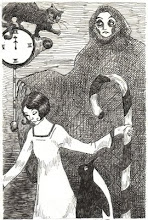 Shaun Tan's The Arrival is simply one of the most beautiful books I've ever seen.
Shaun Tan's The Arrival is simply one of the most beautiful books I've ever seen. I think I've been pretty clear elsewhere in expressing my admiration for the wordless graphic novel. There are so many things the pictures do better, or at least differently from text. For me anyway, pictures are a straighter shot into my cerebellum than words, and I am more likely to have an emotional reaction to the work.
Shaun Tan is a very successful illustrator from Australia. He did the lovely cover for Kelly Link's Pretty Monsters, and has illustrated many, many picture books. He has a wonderful essay on his website in defense of what I often refer to as the "grown up picture book". Nearly everything used to be illustrated. How pictures became (nearly) purely associated with works for children I find somewhat baffling. One of the wonderful side effects of the current popularity of graphic novels, is that it has managed to chip away at at least some of that prejudice.
The Arrival is for everyone. There's no particular reason why children wouldn't enjoy it, but I have a feeling it will mean more to adults. It's a simple, classic, immigrant story. The city a family lives in has become impossible. The father leaves his wife and young daughter and travels to a new city where there will (hopefully) be more opportunity. He travels far and long. He has to find a place to live and navigate a place where everything - the food, the language, how things are done, are different. He has to find a job, which after a few false starts, he does. He meets some other immigrants to the city and hears their stories of diaspora and hope. He sends money home and worries that it won't reach his family. A year passes. He and his wife and daughter are reunited. Simple.
It's how Tan portrays this often told story that is so extraordinary. The hero leaves his home because of encroaching dragons. We see what the city he emigrates to looks like through his eyes. The alphabet used is unrecognizable to us. The animals are strange. The jobs he is asked to perform are as baffling to us, the readers, as they are to the man in the story. Unlike with many classic immigrant tales, we are unable to sit and read of the greenhorn's journey, safely cocooned by a comforting knowledge of the culture in which the immigrant is trying to navigate. In The Arrival we are exactly where he is. The city looks as wondrous and strange to us as New York must have looked to my grandmother when she arrived from rural Albania.
 Shaun Tan's parents emigrated from Malaysia to Sydney in 1960. I think the fact that Tan is Australian and used images from Australia's archives, as well as the more familiar ones from Ellis Island, lends The Arrival a sense of newness and specificity. His pictures eschew boring literalism and take on a kind of surreal longing that I haven't seem in many other places. After finding a room to live in, the man opens his suitcase and we see him looking at the table in his old home, and as he looks at the tiny images of his family the measure of his loneliness is incalculable. Some pages are nearly cinematic. As at left, he uses series of small drawings to portray a sequence in great detail, but then the whole book will open up into a giant panorama.
Shaun Tan's parents emigrated from Malaysia to Sydney in 1960. I think the fact that Tan is Australian and used images from Australia's archives, as well as the more familiar ones from Ellis Island, lends The Arrival a sense of newness and specificity. His pictures eschew boring literalism and take on a kind of surreal longing that I haven't seem in many other places. After finding a room to live in, the man opens his suitcase and we see him looking at the table in his old home, and as he looks at the tiny images of his family the measure of his loneliness is incalculable. Some pages are nearly cinematic. As at left, he uses series of small drawings to portray a sequence in great detail, but then the whole book will open up into a giant panorama.My favorite thing perhaps about The Arrival, is it's utter lack of cynicism. War and dragons and misery of all sorts are seen in the stories of the various immigrants pasts. And the world they have landed themselves in is confusing and scary and not always fair. But it's essentially a gentle story, full of new beginnings and family and making friends and making the best of a scary new world. It's funny, gorgeous and incredibly moving. Language sometimes gets in the way. In The Arrival it would be an unwanted intrusion indeed.


















No comments:
Post a Comment